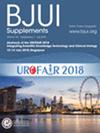前列腺癌筛查中的社会经济差异:地区剥夺指数对PSA筛查频率的影响
IF 4.4
2区 医学
Q1 UROLOGY & NEPHROLOGY
引用次数: 0
摘要
目的探讨区域剥夺指数(Area Deprivation Index, ADI)对北美人群前列腺特异性抗原(PSA)筛查模式的影响,因为社区社会经济劣势对前列腺癌筛查强度的影响分析很少。患者和方法我们纳入了截至2022年12月31日在Henry Ford健康系统接受治疗的所有男性,年龄50-69岁,既往无前列腺癌诊断。每个患者被分配一个基于其人口普查街区组的ADI评分,分为四分位数,第四个四分位数(Q4, ADI 75-100)代表最不利的地区。筛查率的计算方法为PSA检测的总次数除以患者年龄在50岁及以上的年数。多变量泊松回归分析检验了ADI对筛查率的影响。结果在最初纳入的266 203例患者中,有75 958例患者在我院至少进行了一次PSA检测。总体而言,20.9%是非西班牙裔黑人。与最不利四分位数(第一四分位数[Q1])的患者相比,最不利四分位数(Q4)的患者更有可能是非西班牙裔黑人(P < 0.001),合并症发生率更高(P < 0.001),接受两次或两次以上PSA检测的可能性更低(P < 0.001)。泊松回归分析显示,与Q4患者相比,Q1患者、第二和第三四分位数患者接受筛查的概率分别高出1.87倍、1.70倍和1.52倍(P < 0.001)。结论生活在贫困地区与PSA筛查频率较低相关。这些发现强调了社会经济剥夺如何限制获得预防性保健的机会,从而加强了制定更具包容性和针对性的外展战略的必要性。本文章由计算机程序翻译,如有差异,请以英文原文为准。
Socioeconomic disparities in prostate cancer screening: the impact of the Area Deprivation Index on PSA screening frequency.
OBJECTIVE
To investigate the impact of the Area Deprivation Index (ADI) on prostate-specific antigen (PSA) screening patterns in a North American cohort, as the influence of neighbourhood socioeconomic disadvantage on prostate cancer screening intensity has been scantly analysed.
PATIENTS AND METHODS
We included all men receiving care in Henry Ford Health System, aged 50-69 years and without previous prostate cancer diagnosis at the 31 December 2022. Each patient was assigned an ADI score based on their census block group, categorised into quartiles, with the fourth quartile (Q4, ADI 75-100) representing the most disadvantaged areas. The screening rate was calculated as the total number of PSA tests divided by the number of years patients were aged 50 years and older. Multivariable Poisson regression analysis tested the ADI's influence on screening rate.
RESULTS
Among the 266 203 patients initially included, 75 958 patients had at least one PSA test at our institution. Overall, 20.9% were non-Hispanic Black. Patients in the most disadvantage quartile (Q4) were more likely to be non-Hispanic Black (P < 0.001), had higher comorbidity rates (P < 0.001) and lower probability of receiving two or more PSA tests (P < 0.001) compared to the ones in the least disadvantaged quartile (first quartile [Q1]). At Poisson regression analysis, when compared to patients in Q4, patients from Q1, and the second and third quartile had a 1.87-, 1.70-, and 1.52-fold higher probability of receiving screening, respectively (P < 0.001).
CONCLUSIONS
Living in more deprived areas was associated with lower rates of PSA screening frequency. These findings highlight how socioeconomic deprivation may limit access to preventive healthcare, reinforcing the need for more inclusive and targeted outreach strategies.
求助全文
通过发布文献求助,成功后即可免费获取论文全文。
去求助
来源期刊

BJU International
医学-泌尿学与肾脏学
CiteScore
9.10
自引率
4.40%
发文量
262
审稿时长
1 months
期刊介绍:
BJUI is one of the most highly respected medical journals in the world, with a truly international range of published papers and appeal. Every issue gives invaluable practical information in the form of original articles, reviews, comments, surgical education articles, and translational science articles in the field of urology. BJUI employs topical sections, and is in full colour, making it easier to browse or search for something specific.
 求助内容:
求助内容: 应助结果提醒方式:
应助结果提醒方式:


